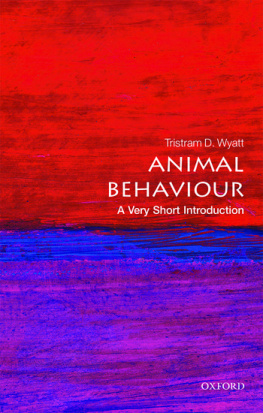PRIMATE FIELD STUDIES
Series Editors:
Robert W. Sussman, Washington UniversitySt. Louis
Natalie Vasey, Portland State University
Series Editorial Board:
Simon Bearder, Oxford-Brookes University
Marina Cords, Columbia University
Agustin Fuentes, Notre Dame University
Paul Garber, University of Illinois
Annie Gautier-Hion, Station Biologique de Paimpont
Joanna Lambert, University of Wisconsin
Robert D. Martin, Field Museum
Deborah Overdorff, University of Texas
Jane Phillips-Conroy, Washington University
Karen Strier, University of Wisconsin
Series Titles:
The Spectral Tarsier
Sharon L. Gursky, Texas A&M University
Strategies of Sex and Survival in Hamadryas Baboons: Through a Female Lens
Larissa Swedell, Queens College, The City University of New York
The Behavioral Ecology of Callimicos and Tamarins in Northwestern Bolivia
Leila M. Porter, The University of Washington
The Socioecology of Adult Female Patas Monkeys and Vervets
Jill D. Pruetz, Iowa State University
Apes of the Impenetrable Forest: The Behavioral Ecology of Sympatric Chimpanzees and Gorillas
Craig B. Stanford, University of Southern California
A Natural History of the Brown Mouse Lemur
Sylvia Atsalis, Lincoln Park Zoo
PRIMATE FIELD STUDIES
Many of us who conduct field studies on wild primates have witnessed a decline in the venues available to publish monographic treatments of our work. As researchers we have few choices other than to publish short technical articles on discrete aspects of our work in professional journals. Also in vogue are popular expositions, often written by nonscientists. To counter this trend, we have begun this series. Primate Field Studies is a venue both for publishing the full complement of findings of long-term studies and for making our work accessible to a wider readership. Interested readers need not wait for atomized parts of long-term studies to be published in widely scattered journals; students need not navigate the technical literature to bring together a body of scholarship better served by being offered as a cohesive whole. We are interested in developing monographs based on single- or multi-species studies. If you wish to develop a monograph, we encourage you to contact one of the series editors.
About the Editors:
Robert W. Sussman (Ph.D. Duke University) is currently Professor of Anthropology and Environmental Science at Washington University, St. Louis, Missouri, and past Editor-in-Chief of American Anthropologist, the flagship journal of the American Anthropological Association. His research focuses on the ecology, behavior, evolution, and conservation of nonhuman and human primates, and he has worked in Costa Rica, Guyana, Panama, Madagascar, and Mauritius. He is the author of numerous scientific publications, including Biological Basis of Human Behavior, Prentice Hall (1999), Primate Ecology and Social Structure (two volumes), Pearson Custom Publishing (2003), and The Origin and Nature of Sociality, Aldine de Gruyter (2004).
Natalie Vasey (Ph.D. Washington University) is currently Assistant Professor of Anthropology at Portland State University in Portland, Oregon. Her work explores the behavioral ecology, life history adaptations, and evolution of primates, with a focus on the endangered and recently extinct primates of Madagascar. She has presented her research at international venues and published in leading scientific journals. She is dedicated to educating students and the public-at-large about the lifestyles and conservation status of our closest relatives in the Animal Kingdom.
First published 2008 by Pearson Education, Inc.
Published 2016 by Routledge
2 Park Square, Milton Park, Abingdon, Oxon OX14 4RN
711 Third Avenue, New York, NY 10017, USA
Routledge is an imprint of the Taylor & Francis Group, an informa business
Copyright 2008 Taylor & Francis. All rights reserved.
All rights reserved. No part of this book may be reprinted or reproduced or utilised in any form or by any electronic, mechanical, or other means, now known or hereafter invented, including photocopying and recording, or in any information storage or retrieval system, without permission in writing from the publishers.
Notice:
Product or corporate names may be trademarks or registered trademarks, and are used only for identification and explanation without intent to infringe.
Credits and acknowledgments borrowed from other sources and reproduced, with permission, in this textbook appear on appropriate page within text.
ISBN: 9780132432719 (pbk)
Cover Design: Kiwi Design
Library of Congress Cataloging-in-Publication Data
Atsalis, Sylvia.
A natural history of the brown mouse lemur / Sylvia Atsalis.
p. cm. (Primate field studies)
Includes bibliographical references and index.
ISBN-13: 978-0-13-243271-9
ISBN-10: 0-13-243271-4
1. Brown mouse lemur. I. Title.
QL737.P933A87 2008
599.83dc22
2007032033
Students of primate behavior often begin their research already devoted to a particular species. Gorillas, chimpanzees and bonobos are common interests, but I have also known colleagues with a fondness for capuchins, colobus, or baboons. If there was any predilection on my part, it was a penchant for the unusual, and a tendency for taking up a challenge. I did not start out loving mouse lemurs. When I began my studies in biological anthropology, my intention was to study the evolution of social behavior. Typically, a study of this nature involves focusing on species that live in social groups in which social interactions are common and visible. Yet, I ended up spending many months following animals that were often not much wider than the leaves behind which they hid, and to whose social interactions I rarely was privy.
In Ranomafana National Park (RNP), mouse lemurs followed the rhythms of the forest. With the rains came the seasonal banquet of fruits and insects. Mouse lemurs gorged themselves into rotund spheres. I called them little bulls, their necks were so puffy with fat. As the rains slackened, fat mouse lemurs sank into a deep sleep, until the shortening of the night whispered that it was time to mate. Testicles, normally shrunken, inflated to the size of small walnuts, and the sealed sexual skin of the females split bloody open to receive eager mates. There was boisterous chatter among the boughs and branches, and wild chases. A few months later, all was quiet as the forest transformed into a nursery where mouse lemur nests were filled with many, tiny, scrawny, grey infants. Within two months, the young, already grown and sporting the bright reddish-brown fur of adults, were initiated into the life cycle. In the rainforest, I discovered, trees and mouse lemurs kept flawless time.








